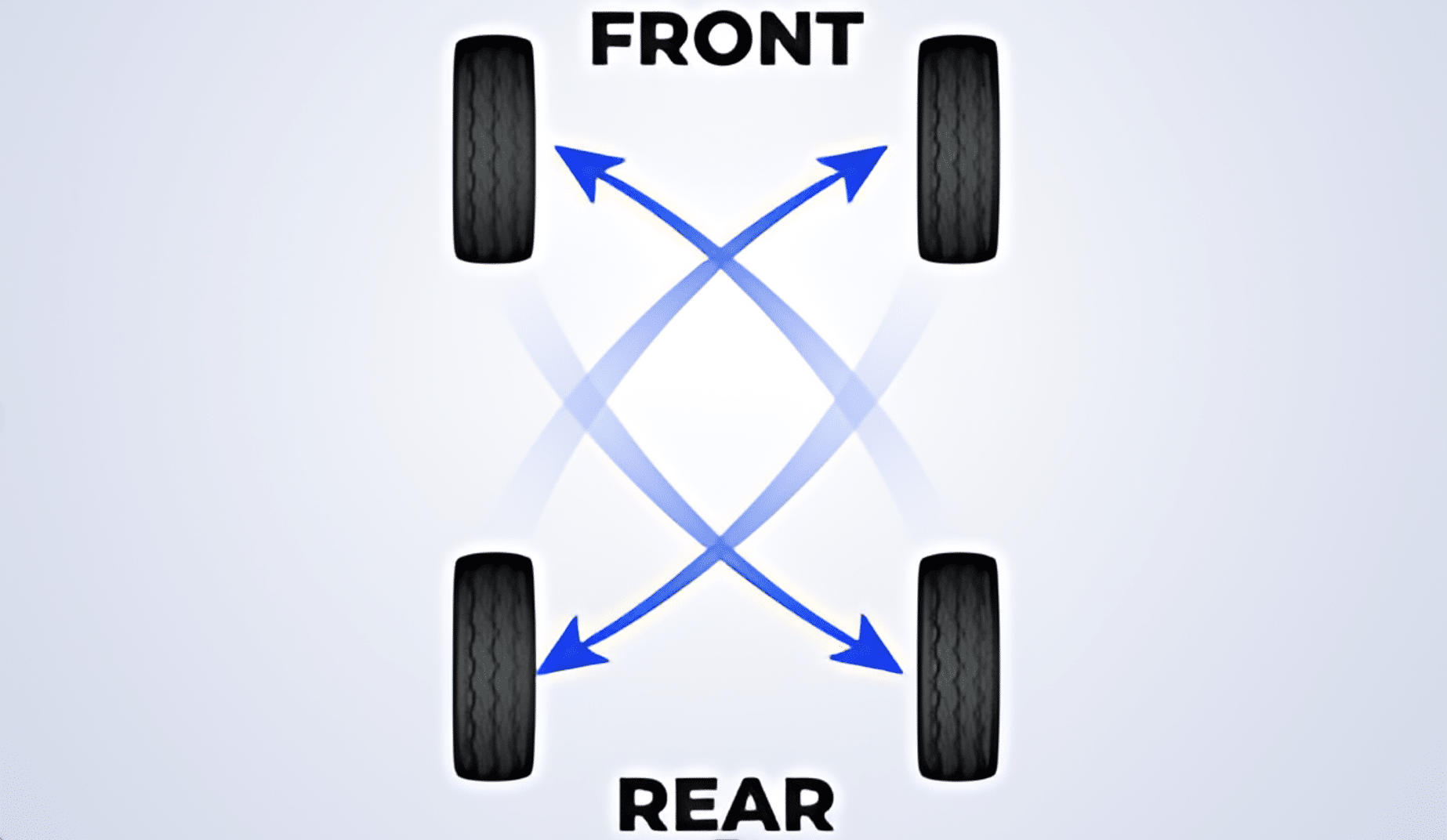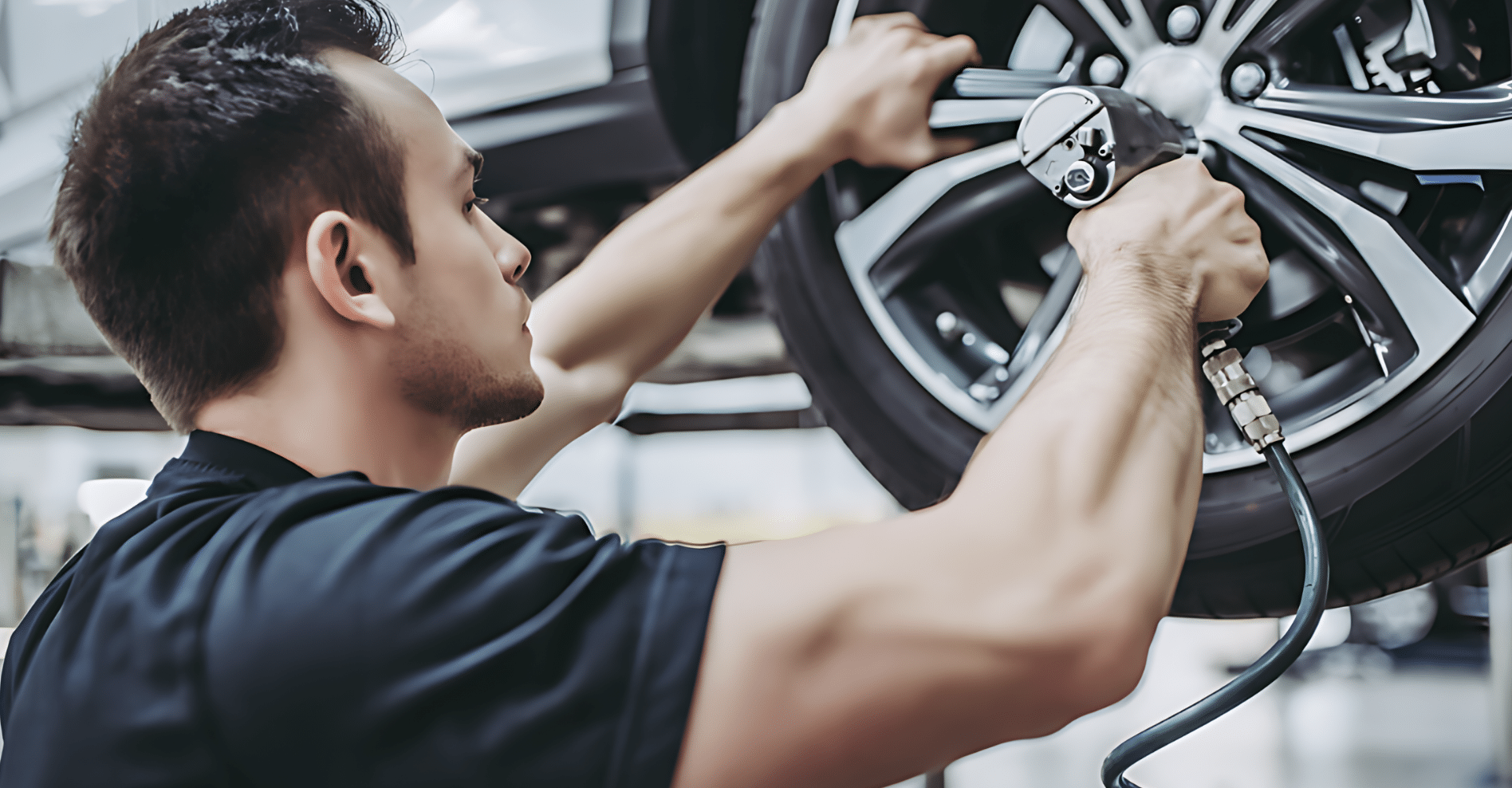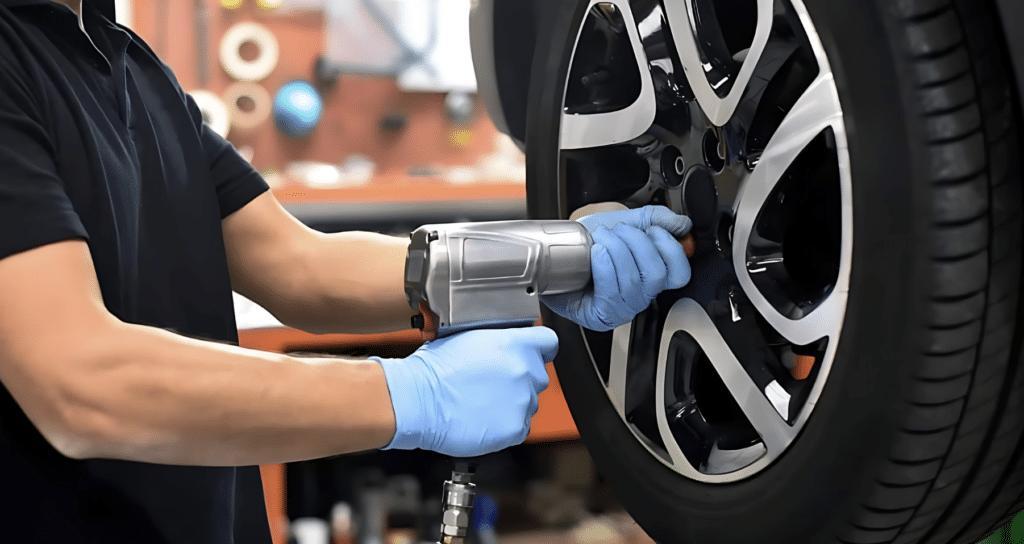Your AWD vehicle is a trusty companion on various roads, but its tires wear unevenly due to different forces acting on each wheel. This can reduce performance, safety risks, and shorter tire life.
Good news! Regular tire rotation can solve these issues, extending the life of your tires and keeping your AWD system running smoothly.
It’s a simple yet effective way to maintain your vehicle’s performance and safety.
This post will explain why tire rotation is crucial for AWD vehicles, how often you should do it, and the correct rotation patterns.
You’ll learn how this simple maintenance task can save you money and keep you safer on the road.
The Importance of Tire Rotation for AWD Vehicles
AWD systems send power to all four wheels, which is great for traction. However, it also means each tire deals with different forces.
Front tires do most of the turning and braking, while rear tires usually follow. This leads to irregular wear patterns across your set of four tires.
Uneven wear can affect your car’s handling. Differences in tread depth can reduce traction, especially on wet roads or during quick turns.
Tire rotation helps spread out the wear more evenly. By moving your tires around regularly, you maintain better car control.
This is crucial when the weather turns bad, or you must suddenly move on the road. Even tread wear helps your AWD system work properly.
When all four tires wear at about the same rate, the system doesn’t have to work overtime to compensate for differences, keeping your car running smoothly and safely.
Recommended Tire Rotation Patterns for AWD Vehicles
When rotating tires on your AWD vehicle, there are a couple of handy patterns to follow. Let’s take a look at the most common ones:
1. The X-Pattern

This is a popular choice for AWD vehicles. Here’s how it works:
- The right front tire moves to the left rear
- The left front tire moves to the right rear
- The right rear tire moves to the left front
- The left rear tire moves to the right front
It’s like making an “X” with your tires. This pattern helps even out wear across all four tires. It’s especially useful if you notice your front tires wearing faster than the rear ones.
2. The Rearward Cross

Another good option for AWD vehicles:
- Both rear tires move straight forward
- The front tires move to the back but switch sides
This pattern is good for vehicles that tend to wear rear tires faster. It’s also helpful if you do a lot of highway driving, as it can help balance out the wear from long stretches of straight-line driving.
How often should you rotate? A good rule of thumb is every 6,000 to 8,000 miles. This usually coincides with your oil changes, making it easy to remember.
Why stick to this schedule? Regular rotation helps your tires wear evenly. This means better handling, improved gas mileage, and longer-lasting tires. Plus, it keeps your AWD system happy and working as it should.
Benefits of Regular Tire Rotation

Regular tire rotation isn’t just a task on your car maintenance checklist. It’s a smart move that pays off in multiple ways.
1. Extended Tire Life
Think of tire rotation like swapping your shoes around. When you wear the same pair every day, they wear out faster. But if you switch between pairs, they all last longer.
By moving tires to different positions, you evenly spread the wear.
This means all your tires last longer, not just one or two. Replacing all four tires at once is cheaper in the long run than replacing them one at a time, and regular rotation helps you do just that.
Many tire warranties require regular rotation. If you follow this schedule, you might save a lot on a replacement.
2. Improved Handling and Performance
Have you ever tried to run in shoes with unstable soles? It’s not fun, right? Your car feels the same way with unevenly worn tires.
Evenly worn tires mean your car handles more predictably. You’ll feel more in control, especially when turning or braking.
Even tread depth on all tires helps maintain traction in tricky conditions like rain or snow. This is super important for safety.
As a bonus, evenly worn tires often make less noise on the road. Enjoy your music, not tired hum!
3. Enhanced Fuel Efficiency
Did you know your tires can affect your gas mileage? It’s true!
Evenly worn tires roll more smoothly. This means your engine doesn’t have to work as hard to move your car. Better fuel efficiency means fewer trips to the gas station. That’s money back in your pocket.
Using less fuel is not just good for your wallet; it’s better for the environment, too.
A Tire Rotation Chart for AWD Vehicles
| Tire Position | Rotation Direction | Explanation |
|---|---|---|
| Front Left (FL) | Move to Rear Right (RR) | The front left tire is moved diagonally to the rear right position. |
| Front Right (FR) | Move to Rear Left (RL) | The front right tire is moved diagonally to the rear left position. |
| Rear Left (RL) | Move to Front Left (FL) | The rear left tire is moved directly forward to the front left position. |
| Rear Right (RR) | Move to Front Right (FR) | The rear right tire is moved directly forward to the front right position. |
Does Weather Affect Tire Wear and Tear?
Weather plays a big role in tire wear. Hot weather can cause faster wear, especially in the center of the tread. Cold weather makes tire rubber stiffer, reducing grip.
Plus, winter roads often have salt that can wear tires faster. Regular rotation helps balance out these effects.
By moving tires to different positions, you spread out the wear caused by temperature changes, allowing your tires to last longer, no matter the weather.
Tire rotation is a real safety booster on wet roads. Good tread depth is crucial for pushing water away from tires and preventing hydroplaning—that scary feeling when your car seems to float on water.
As tires wear, they lose their ability to channel water effectively. By rotating your tires, you ensure all four maintain good tread depth.
This means better traction and shorter stopping distances on wet roads.
By keeping up with tire rotations, you’re ensuring your AWD vehicle is ready to handle whatever weather comes your way.
Potential Cases of Neglecting Tire Rotation in AWD Vehicles
Skipping tire rotation might seem like no big deal, but it can lead to some serious problems for your AWD vehicle. Let’s look at what could go wrong:
1. Stress on the Drivetrain
Your AWD system is designed to work with tires with similar tread depth. When tires wear unevenly, they stress your car’s drivetrain more.
This can lead to premature wear of expensive components like the transfer case or differential.
Replacing these parts can cost a pretty penny – much more than a simple tire rotation!
2. Safety Risks
Unevenly worn tires can affect your car’s handling, especially in tough driving conditions.
Imagine hitting a patch of water or ice with tires that don’t grip the road evenly.
This could lead to losing control, increasing your risk of an accident.
3. Costly Repairs
When tires wear unevenly, you might need to replace them sooner than expected.
And if the wear is really bad, you might have to replace all four tires simultaneously to keep your AWD system happy.
That’s a big hit to your wallet that could have been avoided with regular rotations.
4. Reduced Fuel Efficiency
Tires with uneven wear don’t roll as smoothly. This increased rolling resistance means your engine has to work harder to move your car.
The result? You’ll be spending more at the gas pump. Over time, this extra fuel cost can add up to a significant amount.
5. Uncomfortable Ride
Unevenly worn tires can cause vibrations and noise while driving. This can make for an uncomfortable ride and be annoying on long trips. These vibrations can cause additional wear on other parts of your car.
6. Invalid Warranty
Many vehicle and tire warranties require regular tire rotation. If you skip this important maintenance, you might be unable to claim a warranty.
Additional Maintenance Tips for AWD Vehicles
Tire rotation is key, but it’s not the only thing your AWD vehicle needs. Here are some other important tasks:
- Pair tire rotation with alignment and balancing. This helps tires wear evenly and improves handling. Get an alignment check yearly to see if your car pulls to one side.
- Check tire pressure monthly. The right pressure helps tires last longer and saves fuel. The correct pressure is on the sticker inside your driver’s door frame.
- Use the penny test to check tread depth. If you see all of Lincoln’s head, it’s time for new tires. Uneven wear might mean you need a rotation or alignment.
- Have a professional check your tires during oil changes or see if you notice odd wear or vibrations. They can spot issues you might miss.
- If you use winter tires, rotate them before storing them. Check pressure more often as the seasons change, as temperature affects it.
Following these tips and performing regular rotations will keep your AWD vehicle running smoothly and safely.
A little tire care goes a long way toward extending your vehicle’s life and improving your drive.
Summing It Up!
Rotating your AWD vehicle’s tires isn’t just a maintenance task—it’s a key to unlocking better performance, safety, and savings.
By spreading wear evenly across all four tires, you’ll extend their life and ensure your AWD system works as intended. Remember, rotating every 6,000 to 8,000 miles keeps your ride smooth and your wallet happy.
Don’t let tire rotation fall off your to-do list. Set reminders, keep a log, or use an app to stay on track. Regular rotations will serve you well whether you’re a daily commuter or off-road enthusiast.
Ready to give your AWD vehicle the care it deserves? Schedule a tire rotation today. Your car will thank you with better handling, improved fuel efficiency, and a safer ride for years to come.
Frequently Asked Questions (FAQs)
Can I Rotate My AWD Tires, or Should I Go to a Professional?
Professional service is recommended to ensure correct rotation patterns and additional tire checks.
What Happens if I Don’t Rotate My Tires?
Inconsistent wear, reduced traction, poorer handling, and shorter tire lifespan.
Do All Four Tires Need to be the Same Brand for Rotation?
Ideally, yes. Matching tires ensure consistent performance and wear.

